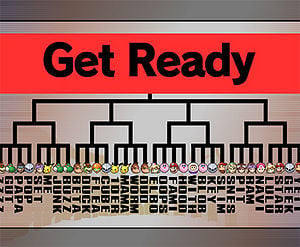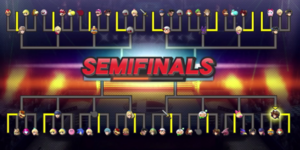Tourney (disambiguation)
- This article is about the game mode. For information on competitive tournaments, see here.
Tournament Mode is a feature in Super Smash Bros. Melee, Super Smash Bros. Brawl, and Super Smash Bros. for Wii U. Tournaments feature three modes:
Tournament
In the tournament mode, players battle against each other in turns. Several options can be chosen for tournaments, including:
- The number of competitors in a tournament (ranging from 4-64 in Melee and Wii U, 32 in Brawl, in two or four player tournaments and 6-27 in three player tournaments)
- The number of computers and humans in a tournament
- How many players fight in each tournament match (In Melee, the number of players only go up when you insert the certain number of controllers. When there are four controllers inserted, two to four players fight in each match, when there are three controllers inserted, two to three players fight in each match, and when there are one or two controllers inserted, two players fight in each match.)
- How stages are selected
- The CPU level of computer players (Levels 1-9 as well as a random option)
- Individual custom rules for matches
In Brawl, there are some more options such as:
- Handicap for individual players and computers
- Set a player to "Drop out" computers that will automatically drop out when their match comes so that people can play with uneven amounts of players.
- One can switch between Samus-Zero Suit Samus, Zelda-Sheik and the Pokémon Trainer's various Pokémon by pressing - on a Wii Remote, the Right Control Stick on a Classic Controller, the C button on a Wii Remote + Nunchuk, and the C stick on a Gamecube Controller.
Wii U features a few options such as:
- Being able to play tourneys created by other people online
- Being able to have Special Smash elements (albeit only those in the Stamina category)
- The ability to determine the winner of a tournament based on points earned or matches won
- How stages are selected
However, the ability to create traditional brackets has been limited to official tournaments hosted by Nintendo. Also, there is no offline option for any Tournament mode.
Loser out
This mode is also played in turns, but unlike Tournament, where the game ends when a final winner is proclaimed, this lasts forever (or at least until the player decides to stop playing). The loser of each match "drops out" and has to wait until it is his or her turn again.
Winner in
This mode is an extension of Loser Out. It is used for Free for All matches containing 3 or 4 players. When a match is complete, all players except the winner swap out. If four players are in each match, the three losers will swap out. Similarly, in 4-player Free for All matches, players may choose to keep the best two players in, while the other two swap out.
Winner out
This mode is exactly the same as the aforementioned loser out mode, except that the winner of each match drops out instead of the loser.
Competitive play
Tournament Mode is never used in actual competitive play, due to a variety of limitations in the mode in comparison to the rather complex structures that serious tournaments require:
- Tournament matches consist of a set of 3 or 5 games, while Tournament Mode only allows single-game sets.
- Tournament matches allow players to use any character for any game in any match, while Tournament Mode forces players to remain a single character for the entire tournament.
- Tournaments almost never use a single-elimination bracket, which is the only bracket type available in Tournament Mode.
- Tournaments require their brackets to be properly seeded for reasonably accurate results, while Tournament Mode gives no control over seeding and forces a randomized bracket.
- Tournaments rarely enforce a limit to the maximum number of players and can contain hundreds of participants, while Tournament Mode cannot handle more than a limited 64 in Melee and a paltry 32 in Brawl.
- Tournaments require multiple setups to be run efficiently, while Tournament Mode can only exist on a single setup.
For the prospect of using Tournament Mode to keep track of a tournament, rather than actually playing a tournament with it, there exists tournament organizing programs such as tio, which are much more efficient in aiding tournament organization than Tournament Mode could ever be. Additionally, using Tournament Mode in such a way uses up setups that could be used to progress the tournament.
| Super Smash Bros. Melee menu items | |
|---|---|
| Vs. Mode | Melee (Time · Stock · Coin Battle · Bonus · Team Battle) · Custom Rules · Special Melee · Tournament Mode · Names |
| 1-P Mode | Regular Match (Classic Mode · All-Star Mode · Adventure Mode) · Event Match · Stadium (Target Test · Home-Run Contest · Multi-Man Melee) · Training |
| Trophies | Gallery · Collection · Lottery |
| Options | Rumble · Sound · Screen Display · Language · Erase Data |
| Data | Snapshots · Melee Records · Sound Test · Archives (NTSC only) · How to Play (PAL only) |
| Unused | Debug menu · Debug sound test menu |
| Super Smash Bros. Brawl menu items | |
|---|---|
| Group | Brawl (Time · Stock · Coin Battle · Team Battle) · Rules · Special Brawl · Rotation · Tourney · Names |
| Solo | Classic · All-Star · Adventure Mode: The Subspace Emissary · Events · Stadium (Target Smash!! · Home-Run Contest · Multi-Man Brawl · Boss Battles) · Training |
| Wi-Fi | Spectator Mode · With Anyone · With Friends |
| Vault | Trophies & Stickers (Trophy Gallery · Trophy Hoard · Coin Launcher · Sticker Album · Sticker Center) · Stage Builder · Album · Challenges · Replays · Masterpieces · Chronicle |
| Options | Screen · Deflicker · Rumble · Controls · Sound · My Music · Erase Data |
| Data | Movies · Records (Group Records · Brawl Records · Notices) · Sound Test |


